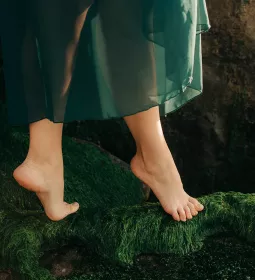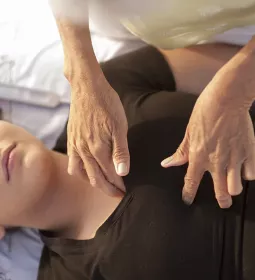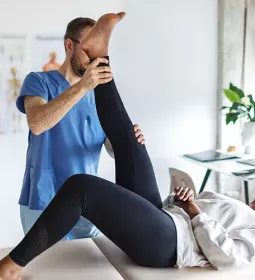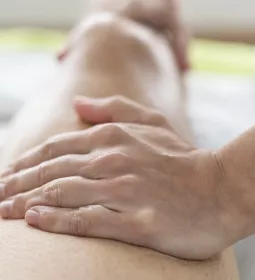“The human foot is a masterpiece of engineering and a work of art.”
— Leonardo da Vinci
Dietrich Miesler, founder of the DayBreak Geriatric Massage Institute, which teaches hands-on work for the elderly, always had the same reply when asked where massage work should start on an elderly client (or anyone experiencing a degenerative condition): “At the feet, where it all begins!”
There are, in fact, several good reasons for beginning a massage at the feet of a client. There are also several good reasons a client may be uncomfortable with you touching their feet at all. Let’s explore some of these reasons.
Foot Functionality
Let’s start by looking at the functionality of the foot.
The Sole of the Foot
We know that skin—our integumentary system—is the largest organ of the human body. And on the soles of our feet, it is crucial to our functionality—it provides constant tactile feedback regarding balance and posture, helps us stay grounded, and assists with spatial awareness and stability.
Nerves and Muscles
The plantar aspect of the foot is comprised of four layers of muscle (which Miesler playfully said reminded him of a “delicatessen sandwich”). Foot muscles are assisted either by the lateral plantar nerve or the medial plantar nerve. The nerves and muscles work together to flex our toes, extend their joints, support our arches, and help our feet maneuver in all directions with strength and balance.
Circulation
Healthy blood flow is crucial to maintaining healthy feet. Our circulatory system is responsible for delivering oxygen and nutrients to our cells throughout the body. And if our blood flow is restricted, those vital deliveries will not be made. Lack of blood flow can be due to various issues, some more serious than others. Damaged blood vessels are often caused by conditions such as diabetes, peripheral vascular disease, and arteriosclerosis.
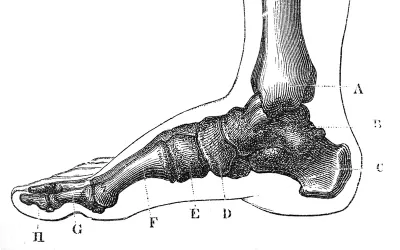
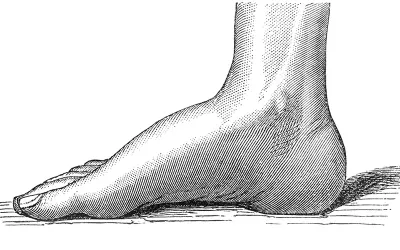
When blood vessels harden, narrow, or close completely, a person can experience a range of outcomes, including numbness, tingling, pain, ulcers that do not heal, toenails that do not grow, decrease in leg hair growth, discoloration of the skin, leg cramping, neuropathy, deep vein thrombosis, and stroke. If a person experiences shortness of breath, pressure in the chest, dizziness, confusion, calf pain with heat, swelling of a limb, or overall weakness, calling 911 is your best line of defense against serious or even fatal outcomes—that applies to the treatment room too. If symptoms are not as serious, there are multiple treatment plans that may help.
Methods for Improved Circulation in the Feet
One of the most important aspects of foot health is circulation. Here are some great tips for elderly clients wanting to improve their circulatory health:
-
Keep the limbs warm.
-
Wear compression socks.
-
Get sufficient exercise.
-
Engage in calming meditation.
-
Pursue appropriate massage therapy techniques, including skillful foot pumping.
What Is Foot Pumping and Why Is It Important?
As part of DayBreak Geriatric Massage protocol, foot pumping is a gentle continuous rocking motion of the ankle through plantar flexion and dorsiflexion for a minimum of one minute. This action will stimulate the venous plexus, the group of veins located on the bottom of the foot. These veins are an enormous help in getting oxygenated blood back to the heart. The action mimics the progression of activity that happens internally and automatically when we walk. Therefore, clients who are sedentary, use a wheelchair, or are in recovery from injury can benefit greatly from this small but powerful motion of foot pumping.
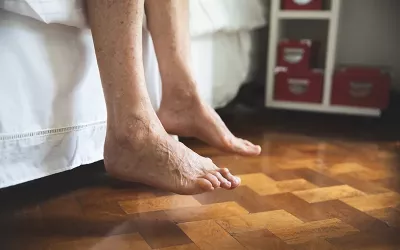
Endothelial dysfunction results in insufficient production of nitric oxide and may be the cause of severe cardiovascular diseases. The widening of the plantar surface and the rhythmic movement of foot pumping stimulate the release of acetylcholine (a vasodilator), which in turn stimulates the release of the “second messenger,” nitric oxide, or EDRF (see “Endothelium-Derived Relaxing Factor” in A Deeper Dive below). This move, continued for up to 10 minutes, helps to increase venous blood return and can even drain edema in paralyzed limbs up to the knee.
Foot Aversions
Despite the importance of working with the feet, what if we encounter clients who prefer we not work with—or even touch—their feet during a massage session? And what are the possible reasons they may feel this way? Let’s consider a few possibilities.
Ticklishness
Some people are so ticklish, they can’t imagine anyone touching their feet, while others view it as a form of torture! (See Cindy Williams’s article, “How to Turn Ticklish Feet into Happy Feet.”) Trick No. 1 here is having firm touch.
Discomfort
If a client is in pain or has a degree of numbness or tingling in their feet, it may be too uncomfortable for them to have you perform the usual active massage strokes to their feet. There may even be a degree of emotional discomfort coming into play, as with clients who no longer have the ability to keep their foot hygiene in check. Or, they may be too embarrassed to allow you to touch their feet. Some clients may prefer you leave their socks on and not expose any dry skin, accumulated dirt, or unkempt toenails. Be willing to accommodate your client to their level of comfort.
Deformity
Another emotional stumbling block may occur if a client has a physical deformity due to a possible birth defect or a case of having had polio as a child, etc. Be extremely sympathetic and understanding of how the client may feel. Never insist on working on someone’s feet; let them know you respect their choice. You can also suggest trying noninvasive holding techniques that may benefit them, if you can both get through it together.
Foot Forewarnings
We often hear the phrase, “Forewarned is forearmed.” In other words, if we know ahead of time about a potential complication, we can arm ourselves with solutions to minimize any or even all negative consequences. So, what does this mean with regard to massaging the feet? Most massage therapists are keenly aware of the dangers of massaging when a client presents with calf pain, especially if the limb is hot to the touch. It’s also common knowledge that massaging a foot that has even the slightest possibility of being broken or fractured presents a huge complication with that foot healing properly. But what about some less-commonly known cases where cautions or contraindications for foot massage come into play? Let’s examine two such cases.
Diabetes
Before beginning any massage session with a client who has diabetes, elderly or not, utmost care should be taken to perform a thorough assessment of the feet and legs. Look for any redness or cuts that have not scabbed over and any open wounds or opportunities for infection. Notice the condition of toenails with possible fungus, varicose veins, broken capillaries, or exaggerated swelling in the limb. People with diabetes often develop neuropathy and can lose sensation in their feet and lower legs. This can lead to larger problems since they often cannot detect a condition that normally causes pain because they no longer feel the pain in that extremity.
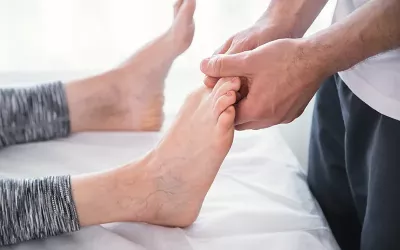
Before proceeding with massaging a client with diabetes, it is necessary to know whether they administer prescribed insulin to keep their blood sugar in balance. If they are insulin-dependent, you will need to know when they received their most recent insulin injection. The dosage amount prescribed is unique to each person’s situation and to the desired outcome of bringing their blood sugar into homeostasis. Proceeding with massage within the first two hours after an insulin injection can cause a hypoglycemic reaction, which can be fatal.
If a client is in pain or has a degree of numbness or tingling in their feet, it may simply be too uncomfortable for them to have you perform the usual active massage strokes to their feet.
The massage focus with clients who have diabetes should always center around improving circulation rather than doing any deeper work, as their vascular system is already compromised and should be handled with care. Miesler believed that cautious, gentle, precise, rhythmic massage techniques could help a considerable number of clients with diabetes lead more comfortable, productive, and happier lives. Miesler’s techniques and consistent treatment sessions promoted enough healing in the circulation of two of his clients that their doctors canceled their amputation surgeries, saving their legs and their ability to use their affected extremities again.
Dementia
The relationship between a massage therapist and a client with dementia is, at the very least, different from their relationship with any other client. In a best-case scenario, the relationship is both intuitive and symbiotic. When working with this client demographic, a helpful suggestion for massage therapists is to begin the session with the client’s hands, not their feet. Often, clients with dementia are challenged in the preservation of their self-awareness. At times, this can cause an adverse reaction to an attempted massage technique. For instance, if a massage therapist began a session at the client’s feet, that part of their body could seem too far away from the core of who they perceive they are (the heart or chest, the face or mind). They may wonder, “What are you doing down there?” which may agitate them and set up the session for failure.
So, although we know that nurturing safe touch can lift the spirit and bring comfort, the way we introduce that touch plays a huge role in the success of a massage session with someone who has dementia.
Acclimating Your Client’s Feet to Touch
Finally, when clients—elderly or otherwise—express fear or concern about their feet being worked on for any reason, I ask permission to rest my hands on their ankle. Then, through a series of movements, along with my asking permission with each new move, we can often work into a full massage of the feet without any ticklishness, pain, or shame. I find it helpful to follow this order for applying technique:
-
Rest your hands on the client’s ankle.
-
Make almost imperceptible circles to the ankle with the heel or palm of your hand.
-
Hold the ankle with both of your hands and stay still for 10–15 seconds.
-
Begin to lightly, slowly, and gently pulse your hands around the ankle.
-
Slowly move your hands down to the sides of the foot and repeat these steps.
The trick is to not use your fingers, unless they are close together and feel to the client as though a larger portion of your hand, like your palm, is being used. You might go only to a certain point of success with your strokes and leave further progress until your next session together. It’s about building trust and communicating with each other about what the client is feeling that will bring you the most success.
Since working with the feet during massage sessions with elderly and compromised clients is so vital and can produce such beneficial results, we should try whatever means possible to involve their feet. This can accomplish an increase of circulation, relax the muscles and tendons, and encourage some movement within their range of motion. Even if you do not have success in accomplishing strokes like effleurage or petrissage with a client’s feet, always remember how beneficial and transformative a simple session of foot pumping can be.
A Deeper Dive—Endothelium-Derived Relaxing Factor (EDRF)
In 1998, Robert F. Furchgott, Louis J. Ignarro, and Ferid Murad were awarded the Nobel Prize in Physiology or Medicine “for their discoveries concerning nitric oxide as a signaling molecule in the cardiovascular system.”1 EDRF is released when a neurotransmitter binds with receptors in endothelial cells lining the artery, which, in response, releases nitric oxide. Nitric oxide molecules from the endothelium travel into smooth muscle cells. After a cascade of cellular reactions, the smooth muscle cells relax and the blood vessel dilates. The nitric oxide compound is also capable of reducing clotting in the blood stream due to its ability to prevent platelet adhesion and aggregation.
Miesler created a hybrid massage stroke called fluffing, a combination of effleurage and petrissage while stroking toward the heart. It works on a microcirculatory level, and when performed shortly after the foot pumping, it extends the benefits of the EDRF release process.
There are electronic devices on the market that simulate the natural stretching and squeezing of the venous plexus that happens when walking. This sounds like a great solution, particularly for clients who use wheelchairs, but it’s nice to know that manual manipulation, delivered with a little love and patience, can affect the same positive changes in the body. I often give the foot pumping exercise to my clients to do while watching television, during a meal while seated at a table, or whenever the mood strikes. And they love knowing they are doing some good for their bodies!
Note
1. The Nobel Prize, “Nobel Prize in Physiology or Medicine 1998,” accessed April 24, 2025, https://nobelprize.org/prizes/medicine/1998/summary.






